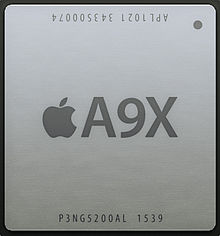Apple A9X
 Apple A9X chip | |
| General information | |
|---|---|
| Launched | September 9, 2015 |
| Discontinued | June 5, 2017 |
| Designed by | Apple Inc. |
| Common manufacturer(s) |
|
| Product code | APL1021 |
| Performance | |
| Max. CPU clock rate | 2.16 GHz[1] to 2.26 GHz[2] |
| Cache | |
| L1 cache | Per core: 64 KB instruction + 64 KB data |
| L2 cache | 3 MB shared |
| Architecture and classification | |
| Application | Mobile |
| Technology node | 16FF+ nm (TSMC)[3] |
| Microarchitecture | Twister[4][5] |
| Instruction set | ARMv8-A: A64, A32, T32 |
| Physical specifications | |
| Cores |
|
| GPU(s) | Custom PowerVR Series7XT (12 cores)[3][6] |
| Products, models, variants | |
| Variant(s) |
|
| History | |
| Predecessor | Apple A8X |
| Successor | Apple A10X |
The Apple A9X is a 64-bit ARM architecture-based system on a chip (SoC) designed by Apple Inc. It first appeared in the iPad Pro, which was announced on September 9, 2015 and was released on November 11, 2015.[7] The A9X has the M9 motion coprocessor embedded in it, something not seen in previous chip generations. It is a variant of the A9 and Apple claims that it has 80% more CPU performance and twice the GPU performance of its predecessor, the A8X.[8]
Design[]
The A9X features an Apple-designed 64-bit ARMv8-A dual-core CPU called "Twister".[5] It offers double the memory bandwidth and double the storage performance of the Apple A8X.[9]
Unlike the A9, the A9X does not contain an L3 cache due to its significant DRAM bandwidth. The A9X is paired with 4 GB of LPDDR4 memory in the 12.9" iPad Pro and 2 GB of LPDDR4 memory in the 9.7" iPad Pro with a total bandwidth of 51.2 GB/s. This high bandwidth is necessary to feed the SoC's custom 12-core PowerVR Series7XT GPU.[10][11] The RAM is not included in the A9X package unlike its sibling, the A9.
The A9X uses the same NAND interface as the A9, which uses an Apple-designed NVMe-based controller that communicates over a PCIe connection.[12] The iPad Pro's NAND design is more akin to a PC-class SSD than embedded flash memory common on mobile devices. This gives the iPad Pro a significant storage performance advantage over competitors which often use mSATA or eMMC to connect to their storage systems.
The support of Codecs by decoding and encoding is available only for JPEG. H264, VP8, AVC and VC1 are available for decoding. HEVC 265 (8/10bit), VP9, AV1 are not supported by hardware. [13]
Products that include the Apple A9X[]
- iPad Pro 9.7-inch (2016)
- iPad Pro 12.9-inch (2015)
See also[]
- Apple silicon, the range of ARM-based processors designed by Apple.
- Apple motion coprocessors
- Comparison of ARMv8-A cores
References[]
- ^ 9.7 inch iPad Pro includes 2 GB RAM, slightly slower CPU than 12.9 inch iPad Pro
- ^ a b "The A9X SoC & More To Come - The iPad Pro Preview: Taking Notes With iPad Pro". AnandTech. November 11, 2015. Retrieved November 11, 2015.
- ^ a b Smith, Ryan (November 30, 2015). "More on Apple's A9X SoC". AnandTech. Retrieved November 30, 2015.
- ^ Joshua Ho. "iPhone 6s and iPhone 6s Plus Preliminary Results". anandtech.com.
- ^ a b Joshua Ho, Ryan Smith. "A9's CPU: Twister - The Apple iPhone 6s and iPhone 6s Plus Review". anandtech.com.
- ^ Kanter, David. "A Look Inside Apple's Custom GPU for the iPhone". Retrieved 2019-08-27.
- ^ "Apple Introduces iPad Pro Featuring Epic 12.9-inch Retina Display" (Press release). Apple. September 9, 2015. Retrieved September 9, 2015.
- ^ Chester, Brandon (September 9, 2015). "Apple Announces the iPad Pro and iPad Mini 4". AnandTech. Retrieved September 9, 2015.
- ^ "Apple's new iPad Pro is an expansive 12.9 inches, available in November". Ars Technica. 9 September 2015. Retrieved 9 September 2015.
- ^ "More on Apple's A9X SoC: 147mm2@TSMC, 12 GPU Cores, No L3 Cache". AnandTech. Retrieved 30 November 2015.
- ^ Kanter, David. "A Look Inside Apple's Custom GPU for the iPhone". Retrieved 2019-08-27.
- ^ "The Apple iPad Pro Review". Retrieved 25 January 2016.
- ^ "Apple A9".
- Apple Inc. mobile processors
- ARM architecture
- Computer-related introductions in 2015
